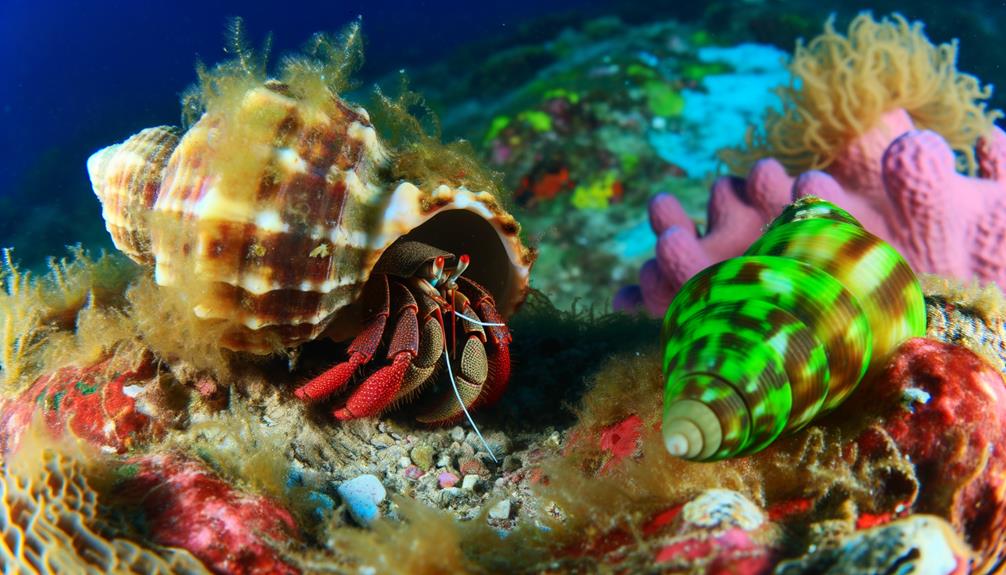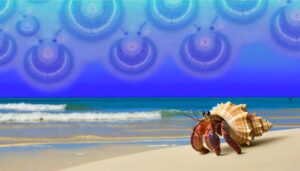How to Recognize and Avoid Bad Painted Hermit Crab Shells
Yes, painted hermit crab shells are detrimental to their health. The toxic chemicals in paint, like lead and cadmium, pose severe health risks.
Hermit crabs can ingest harmful substances, leading to long-term health issues or death. The compromised structural integrity of painted shells makes them prone to breakage, leaving crabs vulnerable.
The presence of paint chips can damage gills and impair respiratory functions. Additionally, painted shells contribute to environmental pollution, affecting marine biodiversity.
Natural shell options are crucial for hermit crabs' well-being and maintaining ecological balance. Here's what you need to know to make sure your hermit crabs stay healthy.

Key Takeaways
- Painted shells pose health risks due to toxic chemicals and structural weaknesses.
- Ingesting paint chips can harm hermit crabs' gills and internal organs.
- Painted shells can disrupt natural shell selection and molting behavior.
- Chemical exposure from paint can lead to long-term health issues or mortality.
- Painted shells contribute to environmental pollution and ecological imbalances.
Understanding Hermit Crabs
Hermit crabs, which belong to the superfamily Paguroidea, are fascinating crustaceans known for their unique behavior of occupying discarded shells to protect their soft abdomens.
You'll find that these creatures aren't just mindless scavengers; they demonstrate complex decision-making processes. Studies indicate that hermit crabs assess shell quality based on size, weight, and condition.
They're highly social and exhibit behaviors like shell exchanges during communal gatherings. Understanding their biology is essential for their well-being. For instance, they require a habitat with proper humidity, temperature, and access to both fresh and saltwater.
Natural Shell Selection
In natural environments, hermit crabs carefully evaluate potential shells based on factors like size, structural strength, and previous wear. They rely on these assessments to guarantee optimal protection and mobility.
Size is pivotal as an ill-fitting shell can hinder growth and increase vulnerability to predators. Structural strength ensures the shell can withstand environmental pressures, while minimal previous wear indicates longer usability.
Studies have shown that hermit crabs often engage in shell exchanges, demonstrating a communal approach to shell selection. By understanding these natural behaviors, you can better assist in providing suitable living conditions for hermit crabs in captivity.
Prioritizing their natural selection criteria ensures their well-being and aligns with their evolutionary adaptations.
The Painted Shell Trend
Despite their aesthetic appeal, painted shells often pose significant health risks to hermit crabs due to toxic chemicals and compromised structural integrity.
When hermit crabs inhabit these shells, they can ingest or absorb harmful substances, leading to long-term health issues or even mortality. Studies indicate that paint chips can damage a crab's gills, impairing respiratory function.
Additionally, the structural integrity of painted shells is frequently inferior, making them more prone to breakage. This can leave hermit crabs vulnerable to predators and environmental stressors.
Types of Paint Used
Several types of paint used on hermit crab shells contain toxic chemicals like lead, cadmium, and volatile organic compounds (VOCs). These paints aren't only harmful to the hermit crabs but also pose risks to their environment.
The most common types of paint used include:
- Acrylic Paints: Often water-based but can contain harmful additives.
- Enamel Paints: Known for their durability; however, they frequently contain VOCs.
- Spray Paints: Easy to apply but typically high in toxic chemicals.
- Oil-Based Paints: Durable and vibrant but rich in hazardous substances.
Understanding the types of paint and their components can help you make informed decisions that prioritize the well-being of hermit crabs and their habitats.
Toxicity Concerns
Toxicity concerns arise from the harmful chemicals in paints, which can leach into the hermit crab's shell and surrounding environment, leading to serious health issues. These chemicals often include heavy metals and solvents that are toxic to marine life. Studies have shown that exposure to such toxins can result in weakened exoskeletons, respiratory distress, and even mortality in hermit crabs. Additionally, the ingestion of paint chips can cause internal damage and digestive blockages.
Behavioral Effects
In addition to health risks, painted hermit crab shells can significantly alter natural behaviors, disrupting their social interactions and habitat preferences. Hermit crabs have distinct preferences for shell types and colors, often avoiding unnatural, painted options. This can lead to:
- Social isolation: Crabs may avoid others with painted shells, reducing essential social interactions.
- Habitat disruption: Crabs mightn't burrow properly due to the altered weight and texture of painted shells.
- Increased aggression: Limited suitable shells can lead to fights and stress among hermit crabs.
- Reduced mobility: Paint can make shells heavier and more cumbersome, impairing the crab's ability to move efficiently.
These behavioral changes can significantly impact their well-being, emphasizing the importance of providing natural, unpainted shells.
Health Risks
Paint used on hermit crab shells can contain harmful chemicals that leach into their bodies, posing significant health risks. You need to understand the specific dangers these chemicals present. For instance, lead and other heavy metals often found in paint can cause neurological impairments in hermit crabs. Additionally, the ingestion of paint flakes can block their digestive systems, leading to malnutrition or even death.
| Chemical | Health Risk |
|---|---|
| Lead | Neurological impairments |
| Cadmium | Organ damage |
| Phthalates | Hormonal disruptions |
| Benzene | Carcinogenic effects |
| Acrylic polymers | Digestive blockages |
It's essential to recognize these risks and opt for natural shells. By doing so, you're ensuring the health and well-being of these delicate creatures.
Environmental Impact
When hermit crabs use painted shells, the environmental impact can be profound. Discarded shells with toxic chemicals contribute to soil and water pollution, leaching into ecosystems and disrupting the delicate balance of marine and terrestrial environments.
You should consider several detrimental effects:
- Chemical Contamination: Paints often contain heavy metals and other toxins that harm microorganisms and larger wildlife.
- Microplastic Pollution: Shell fragments can break down into microplastics, affecting marine food chains.
- Habitat Degradation: Polluted habitats can become unsuitable for native species, diminishing biodiversity.
- Long-term Ecosystem Impact: Persistent pollutants can accumulate, leading to chronic environmental health issues.
Safer Alternatives
You can opt for natural shell options to guarantee hermit crabs' wellbeing and ecological balance. Studies indicate that sustainably sourced shells reduce environmental damage and support natural behaviors in hermit crabs.
Natural Shell Options
Why not consider natural shell options that provide safer and more sustainable alternatives for hermit crabs? Scientific evidence indicates that natural shells notably reduce the risk of toxic exposure.
Hermit crabs naturally seek out these shells, ensuring a better fit and enhancing their overall well-being. By offering natural shells, you can contribute to their health and longevity.
Here are some natural shell options you might consider:
- Turbo shells: Known for their durability and perfect fit.
- Murex shells: Provide ample space and promote growth.
- Babylonia shells: Smooth interior surfaces minimize irritation.
- Nerite shells: Lightweight and easy for crabs to maneuver.
Sustainable Shell Sourcing
Sourcing shells responsibly not only secures the availability of safer alternatives for hermit crabs but also promotes environmental conservation and biodiversity. When you select naturally occurring shells that have been ethically harvested, you're supporting ecosystems by maintaining marine habitats. Evidence indicates that overharvesting can disrupt ecological balance, causing a decline in species that rely on these shells.
Expert Opinions
Consulting marine biologists reveals that painting hermit crab shells can introduce harmful toxins into their environment. These experts emphasize that the chemicals in paint, such as heavy metals and solvents, pose significant risks to the crabs' health.
The paint can chip off, leading to ingestion and internal damage. Moreover, painted shells can disrupt the natural selection process for suitable homes.
To summarize the key points:
- Chemical Exposure: Paint contains toxins like lead and cadmium, harmful to hermit crabs.
- Behavioral Impact: Painted shells can deter natural behavior, including shell selection and molting.
- Ecological Imbalance: Introducing non-natural elements disrupts the marine ecosystem.
- Health Risks: Ingested paint chips can cause internal injuries and potential long-term health issues.
Conclusion
To wrap up, using painted shells for hermit crabs is like putting a wolf in sheep's clothing—dangerous and misleading.
The paint's toxicity poses significant health risks and environmental harm.
Instead, opt for natural shells, which align with their instinctive behavior and promote well-being.
Expert opinions and evidence-based research unanimously suggest safer alternatives, ensuring your hermit crab thrives without unnecessary risks.
Choose wisely; their tiny lives depend on it.






